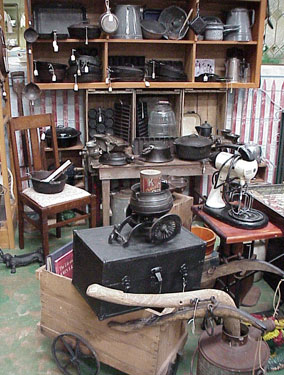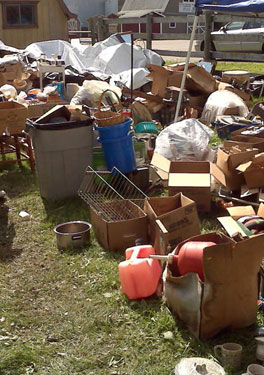
 by Jennifer Jones
by Jennifer Jones
Hoarding has become an increasing problem for many Americans in the United States. There are several dangers caused by the unhealthy collection of clutter and trash in the home. Mold easily develops in this type of environment, as well as bugs and mice that leave behind harmful excrement and cause damage to the walls and floors. Many hoarders also suffer from embarrassment from all the clutter invading their lives and self-esteem issues. However, it is completely achievable to overcome a hoarding problem and take charge of your life once again.
Why do people hoard?
A lot of people have the wrong impression about the personality of a hoarder. It is common to think that all hoarders are poorly educated individuals, when in fact most hoarders are intelligent, professional people. Individuals initially start showing inclinations of a hoarding problem from the ages of 5 to 15 years old. There are a number of reasons that can cause an individual to hoard. For some, it is an obsessive compulsive behavior that gives them the feeling of “I cannot throw this away; it may be useful someday.” Certain people will develop close, personal ties with the objects that make it extremely hard for them to part with the items. Some individuals learn hoarding from their parent’s hoarding issues. They were never taught the appropriate example of how to live comfortably with their personal items. Other hoarders have been raised in a household where everything was done for them, so they never learned important life skills like how to organize and clean for themselves.

Who does hoarding affect?
Hoarding is damaging to not only the hoarder, but also family members and friends. The hoarder develops conflicting and unhappy emotions over feeling helpless to correct the problem. They also feel guilty knowing that their problem is causing pain and discomfort to their loved ones. The hoarding items begin to replace their personal relationships and they become more and more detached from the real world.
Family members who live with a hoarder are impacted just as strongly. Since the hoarding can be incredibly difficult to live with, they acquire negative feelings towards the hoarder as the collections pile up over the weeks, months and years. The loved ones usually reach a point where they either give the hoarder an ultimatum, or they submit to enabling the hoarder. The longer that they do not express their dissatisfaction with the issue, the more time spent piling up the objects.
How to help a hoarder
The first step is to understand the feelings of everyone who is involved and to be able to talk openly about the problem. The hoarder will have to be determined to correct the problem or chances are that they will fall back into their comfortable ways. It is important to be sensitive with the hoarder and not push them too hard or they will shut down. Try to understand their feelings and what they are going through. A positive, strong relationship should be achieved in order for them to trust that you want to help with their problem, and not just throw away their possessions. Positive wishes of a future without clutter should be expressed to encourage the hoarder and remind them that this issue can be resolved with assistance. Help them understand that “things” do not control their lives and encourage them to take back control of their surroundings. This can often be extremely enlightening for a hoarder who has felt so distressed over the years. Allow the hoarder to move at his/her own pace as progress is gained. The power of understanding and de-cluttering can lead the hoarder on a path to recovery.

Tips for de-cluttering a hoarder
Once the hoarder is prepared and determined to fix the situation, it is time to start the clean-up process. This still may be incredibly draining for the hoarder, both emotionally and physically. Remember, they have been living with many of these items for years and come to cherish them. However, keep up the positive attitude and remind the hoarder that they are in control and should feel a sense of accomplishment with their progress. Here is a list of useful tips when approaching the de-cluttering process:
-
Start Small. Beginning the process is the hardest part. Pick a little section of the clutter and focus on those items. Picking through small amounts at one time will keep the hoarder motivated and most likely they will continue on feeling comfortable.
-
Designate three piles. One pile is for keepers, another is the throw away pile and the final one is donations. Try to maintain the “keep” pile as small as possible. For those having issues deciding, encourage them to consider how long they have had that particular item. If they have had if for years and have hardly used it, chances are they do not need it and should donate or throw away. Donating items often proves to be a motivating factor for some hoarders dealing with mixed emotions. Although they will not have the item, it will be going to good use for someone else.
-
Regularly dispose of the piles. This will allow the hoarder to really see the progress that they are achieving as the throw away and donated items are removed from the area. It also prevents them from second-guessing their decisions and promotes further progress.
-
Three-second decisions. Although you want to keep the hoarder comfortable, encourage them to take three seconds to decide on an item. This will keep the process flowing at a steady pace and get more accomplished by the end of the day.
-
Take breaks when needed. Since this can be an incredibly exhausting task, be sure to not overwhelm the hoarder. Reassure them that is fine to take a breather if they are feeling drained. Just be sure to support their feelings and encourage them to continue on selecting items after they have rested.

Keeping the clutter out
Once the de-cluttering process is finished, the hoarder will likely have a wide array of emotions. Hopefully, they will mostly feel accomplished with taking back the power to organize and clean their home. However, just because the hoard has been removed, they will still need support to remain clutter-free. Regularly clean out expired medications and foods, as well as old newspapers, books and clothes that no longer fit. One rule of thumb to remain tidy is to get rid of one old item for every new item that you bring into the house. Every item should have a specific place in the home. This will keep things organized and keep out items that are unnecessary. Also, a former hoarder should make an effort to organize every day and keep things in drawers and their proper storage containers.
Hoarding can turn into a dangerous and unhealthy situation if not properly addressed. It is not an impossible task to clean and de-clutter a home with enough assistance. Plenty of positive encouragement can go a long way to help in a hoarding situation. In the long run, they will be reclaiming their self-esteem and their right to live clutter-free.
Here are some related articles:
- A Holistic Home - Living Your Best Life
- Beating the Winter Blues
- Cut the Clutter: A Kitchen Designed for Function
- Get Organized
- Healthy Home Trends
- Healthy Living - Spring Cleaning Tips
- Keeping Healthy Homes
- Keeping Out Household Pests
Save this article to:
back to top